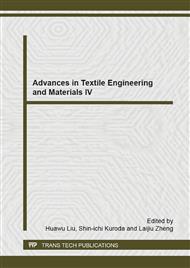[1]
PAN Zhijuan, The simulation technology and application of fabric shape style [J], Silk Textile Technology Overseas, 1999 (4): 7-10.
Google Scholar
[2]
Peirce F T. The geometry of cloth structure[J]. J. Text. Inst., 1937, 28: T45.
Google Scholar
[3]
Peirce F T. The handle of cloth as a measurable quantity[J]. Journal of the Textile Institute. 1930, 21, T377.
DOI: 10.1080/19447023008661529
Google Scholar
[4]
Chu C C, Cummings C L and Teixeria N A. Mechanics of elastic performance of texile materials, Part Ⅴ: Aa study of the factors affecting the drape of fabrics -The development of a drape meter. Textile Res, 1950(08).
DOI: 10.1177/004051755002000802
Google Scholar
[5]
Cusick, G. E. The Measurement of Fabric Drape [J]. Text. Inst. 1968, 59(6):253-260.
Google Scholar
[6]
Kawabata, S. The standardization and analysis of handle evaluation [D]. The Textile Machinery Society of Japan, Osaka, Japan, (1980).
Google Scholar
[7]
Niwa. M, Seto. F. Relationship between drape-ability and mechanical properties of fabrics [J]. J. Textile Machin. Soc. Jpn. 1986, 39(11): 161-168.
Google Scholar
[8]
Morooka H, Niwa M. Relation between drape coefficients and mechanical properties of fabrics [J]. Journal of the Textile Machinery Society of Japan, 1976, 22(3): 67-73.
DOI: 10.4188/jte1955.22.67
Google Scholar
[9]
CAIRO, A Wool Corporation, Fabric Assurance by Simple Testing INSTRUCTION MANUAL,Australian,(1989).
Google Scholar
[10]
Kenkare N, May-Plumlee T. Fabric drape measurement: a modified method using digital image processing [J]. Journal of Textile and Apparel, Technology and Management, 2005, 4(3): 1-8.
Google Scholar
[11]
ZHANG Yu, Research of silk shape style –The generated, testing and evaluation of silk dress material shape style information [J]. Journal of Soochow University (Natural Science Edition), 1990, 1: 003.
Google Scholar
[12]
GUO Yupeng, WU Zhaoping. Applying computer image processing to research draping property of fabric[J]. Shanghai Textile Science & Technology, 2001, 29(2): 51-52.
Google Scholar
[13]
ZUO Tonglin, LI Ruqin, Study on selection of evaluation index of fabric static drape [J]. Journal of Donghua University (Natural Science Edition), 2004, 10.
Google Scholar
[14]
Stylios G, Wan T R, Powell N J. Modelling the dynamic drape of fabrics on synthetic humans: a physical, lumped-parameter model[J]. International Journal of Clothing Science and Technology, 1995, 7(5): 10-25.
DOI: 10.1108/09556229510100474
Google Scholar
[15]
ZHOU Hua, SHEN Yi, CHEN Huilan, etc. The development of ZYF - 1 type of fabric drape tester [J]. Journal of Zhejiang Institute of Silk Textiles, 1996, 13(3): 1-5.
Google Scholar
[16]
GUO Yongping. The research of Dynamic and static fabric drapes evaluation method. [D]. Shanghai:Donghua University, (2000).
Google Scholar
[17]
XU Jun, YAO Mu. [J]. A study on relation between drape of fabrics and its revolving speed. Journal of Northwest Institute of Textile Science and Technology, 2001, 15(2): 122-125.
Google Scholar
[18]
XU Jun, YAO Mu. The study of objective evaluation of fabric drapability[J]. Journal of Textile Research, 1999, 4(11).
Google Scholar
[19]
HAN yanlin, QIANG Shasha. The research of fabric digital dynamic drape style instrument[J]. Shandong Textile Science & Technology, 2002, 43(6): 35-38.
Google Scholar
[20]
Matsudaira. The Society of Fiber Science and Technology, 1998 (9): 13-18.
Google Scholar
[21]
YANG Minzhuang. The Society of Fiber Science and Technology, 1999(09): 43-51.
Google Scholar
[22]
ZHANG Guangjun. Visual measurement [M]. Beijing: Science Press, (2008).
Google Scholar
[23]
Bhat K S, Twigg C D, Hodgins J K, et al. Estimating cloth simulation parameters from video[C]/Proceedings of the 2003 ACM SIGGRAPH/Eurographics symposium on Computer animation. Eurographics Association, 2003: 37-51.
Google Scholar
[24]
GUANG Fangli, PAN Rongjiang. 3D simulation of jacquard fabrics based on micro CT scan [J]. Journal of Computer-Aided Design & Computer Graphics, 2013, 4.
Google Scholar
[25]
JIN Shoufeng, HU Yongbiao. Image-based non-contact measurement method of fabric moving speed[J]. Journal of Textile Research, 2013. 4.
Google Scholar
[26]
Guskov I. Efficient tracking of regular patterns on non-rigid geometry[C]/Pattern Recognition, 2002. Proceedings. 16th International Conference on. IEEE, 2002, 2: 1057-1060.
Google Scholar
[27]
Guskov I, Zhukov L. Direct pattern tracking on flexible geometry[C]. /Proceedings of Winter School of Computer Graphics. Plzen, Czech: 2002. 203-208.
Google Scholar
[28]
HERNANDEZ, C., VOGIATZIS, G., CIPOLLA, R. Multi-view photometric stereo. IEEE Transactions on Pattern Analysis and Machine Intelligence, 2008, 3(30): 548–554.
DOI: 10.1109/tpami.2007.70820
Google Scholar
[29]
Mongus D, Repnik B, Mernik M, et al. A hybrid evolutionary algorithm for tuning a cloth-simulation model[J]. Applied Soft Computing, 2012, 12(1): 266-273.
DOI: 10.1016/j.asoc.2011.08.047
Google Scholar
[30]
Ma L, Hu J, Baciu G. Generating seams and wrinkles for virtual clothing[C]/Proceedings of the 2006 ACM international conference on Virtual reality continuum and its applications. ACM, 2006: 14-17.
DOI: 10.1145/1128923.1128957
Google Scholar


